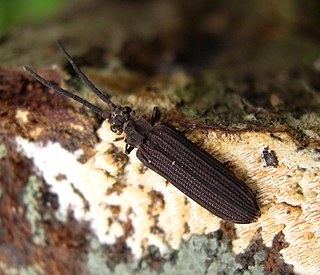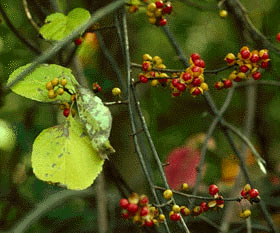The Cretaceous is a geological period that lasted from about 145 to 66 million years ago (Mya). It is the third and final period of the Mesozoic Era, as well as the longest. At around 79 million years, it is the longest geological period of the entire Phanerozoic. The name is derived from the Latin creta, "chalk", which is abundant in the latter half of the period. It is usually abbreviated K, for its German translation Kreide.
The Mesozoic Era, also called the Age of Reptiles and the Age of Conifers, is the second-to-last era of Earth's geological history, lasting from about 252 to 66 million years ago and comprising the Triassic, Jurassic and Cretaceous Periods. It is characterized by the dominance of archosaurian reptiles, like the dinosaurs; an abundance of conifers and ferns; a hot greenhouse climate; and the tectonic break-up of Pangaea. The Mesozoic is the middle of the three eras since complex life evolved: the Paleozoic, the Mesozoic, and the Cenozoic.

Gnetophyta is a division of plants, grouped within the gymnosperms, that consists of some 70 species across the three relict genera: Gnetum, Welwitschia, and Ephedra. Fossilized pollen attributed to a close relative of Ephedra has been dated as far back as the Early Cretaceous. Though diverse in the Early Cretaceous, only three families, each containing a single genus, are still alive today. The primary difference between gnetophytes and other gymnosperms is the presence of vessel elements, a system of conduits that transport water within the plant, similar to those found in flowering plants. Because of this, gnetophytes were once thought to be the closest gymnosperm relatives to flowering plants, but more recent molecular studies have brought this hypothesis into question.

The Cupedidae are a small family of beetles, notable for the square pattern of "windows" on their elytra, which give the family their common name of reticulated beetles.

The Celastraceae are a family of 97 genera and 1,350 species of herbs, vines, shrubs and small trees, belonging to the order Celastrales. The great majority of the genera are tropical, with only Celastrus, Euonymus and Maytenus widespread in temperate climates, and Parnassia (bog-stars) found in alpine and arctic climates.

The pied thrush is a member of the thrush family found in India and Sri Lanka. The males are conspicuously patterned in black and white while the females are olive brown and speckled. They breed in the central Himalayan forests and winter in the hill forests of southern India and Sri Lanka. Like many other thrushes, they forage on leaf litter below forest undergrowth and fly into trees when disturbed and sit still making them difficult to locate.
The Late Cretaceous is the younger of two epochs into which the Cretaceous Period is divided in the geologic time scale. Rock strata from this epoch form the Upper Cretaceous Series. The Cretaceous is named after creta, the Latin word for the white limestone known as chalk. The chalk of northern France and the white cliffs of south-eastern England date from the Cretaceous Period.
In the geologic timescale, the Valanginian is an age or stage of the Early or Lower Cretaceous. It spans between 139.8 ± 3.0 Ma and 132.9 ± 2.0 Ma. The Valanginian Stage succeeds the Berriasian Stage of the Lower Cretaceous and precedes the Hauterivian Stage of the Lower Cretaceous.

Mapusaurus was a giant carcharodontosaurid carnosaurian dinosaur from the early Late Cretaceous, approximately 93.9 to 89.6 million years ago, of what is now Argentina.

Rinconsaurus is a genus of titanosaur sauropod dinosaur from the Late Cretaceous in what is now Argentina. The type species, Rinconsaurus caudamirus, was described by Calvo and Riga in 2003, and is based on three partial skeletons.
Zapalasaurus is a genus of sauropod dinosaur described by Leonardo Salgado, Ismar de Souza Carvalho and Alberto Garrido in 2006. It was named after the city of Zapala, which is approximately 80 kilometres (50 mi) away from where the holotype was discovered. The type species, Zapalasaurus bonapartei, was found in the La Amarga Formation of the Neuquén Basin, Neuquén Province, Argentina. It was a diplodocoid, a long-necked herbivore, and it lived during the Early Cretaceous. The authors conclude from examining the skeleton that "The record of Zapalasaurus bonapartei shows that, at least in the Neuquén Basin, basal diplodocoids were more diverse than previously thought." Zapalasaurus is assumed to have a long neck which would have been developed for feeding adaption, allowing its neck to swing in an arc like shape. This would allow Zapalasaurus to browse a wide variety of plants and greens without having to walk very far.
The Paleocene, or Palaeocene, is a geological epoch that lasted from about 66 to 56 million years ago (mya). It is the first epoch of the Paleogene Period in the modern Cenozoic Era. The name is a combination of the Ancient Greek παλαιός palaiós meaning "old" and the Eocene Epoch, translating to "the old part of the Eocene".

Paphiopedilum wardii is a species of orchid found from southwestern Yunnan to Myanmar.

Stanhopea wardii is a species of orchid found from Nicaragua to Venezuela.
Oonopsis, or false goldenweed, is a genus of flowering plants in the family Asteraceae.
Schizopodidae is a family of beetles, in the large suborder Polyphaga. It was a subfamily until 1991, when it was elevated to family status.

Roscoea wardii is a perennial herbaceous plant occurring from eastern Arunachal Pradesh in India to western Yunnan in China. Most members of the ginger family (Zingiberaceae), to which it belongs, are tropical, but like other species of Roscoea, R. wardii grows in much colder mountainous regions.

Brachyphyllum is a form genus of fossil coniferous plant foliage. Plants of the genus have been variously assigned to several different conifer groups including Araucariaceae and Cheirolepidiaceae. They are known from around the globe from the Late Carboniferous to the Late Cretaceous periods.

The Cretaceous–Paleogene (K–Pg) extinction event was a sudden mass extinction of three-quarters of the plant and animal species on Earth, approximately 66 million years ago. With the exception of some ectothermic species such as sea turtles and crocodilians, no tetrapods weighing more than 25 kilograms survived. It marked the end of the Cretaceous Period, and with it the Mesozoic era, while heralding the beginning of the Cenozoic era, which continues to this day.
Algoa Basin is a sedimentary basin offshore Algoa Bay in South Africa. The basin depression is a rift currently filled with sediments of Lower Cretaceous age. Kirkwood Formation makes up part of the fill of Algoa Basin.










